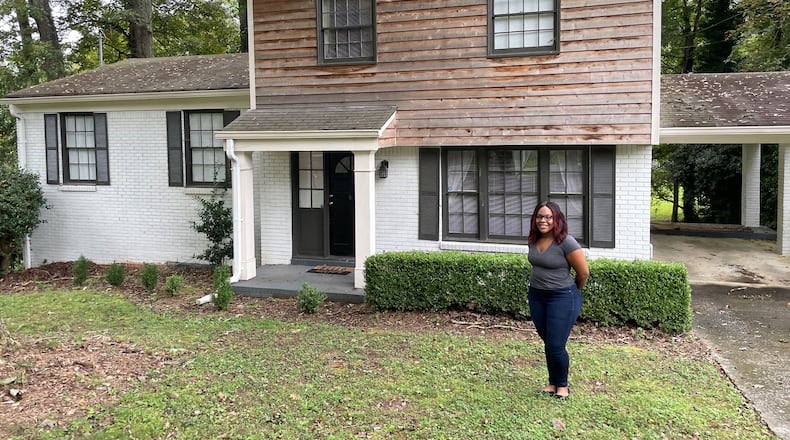Collier Heights is an officially designated historic district, a 1,750-home enclave mostly made up of brick ranch houses built in the 1950s and 1960s. It was home to Martin Luther King Sr. and Ralph David Abernathy and, according to Atlanta code, is a “mid-20th century suburb created for African Americans, by African Americans.”
But that historic designation, meant to “preserve the integrity of the neighborhood,” is sneaking up and biting several new residents, almost all of whom are African American.
The northwest Atlanta neighborhood has seen a constant turnover in recent years as the older generation either dies off or moves on. The new homebuyers were excited by the community’s affordability and its quaint, tree-lined charms until they started getting citations from the city that threaten to cost them thousands of dollars.
This week, I spoke with five new homeowners who’ve been cited in the past couple of months, accused of breaking the historic district’s regulations. The one commonality: They have painted brick on their homes. None of them actually painted the houses. They bought them that way and all say they liked the aesthetic. That doesn’t matter. City officials want them to remove it at great cost. Or else.
Shaina Riggins, 29, a marketing research manager, bought her home in April 2020 from a real estate agent who flipped the home. It turns out that Riggins paid $204,000 to buy herself trouble.
A month before she bought the house, in March 2020, the city had placed a “stop work” order stating “applicant has possibly painted the brick without (city) approval.” The Florida native unknowingly signed the closing papers, bought new furniture, celebrated Christmas with her family, and enjoyed her new life as a homeowner until this August — when she got the city paperwork chiding her for the paint job.
Then, a couple of days before her hearing last month before the Atlanta Urban Design Commission, she said she got hit with several other demands telling her to replace the new siding, add a screen door, reinstall iron columns on the porch, and prove that she didn’t replace the drafty 1960s windows.
“You buy a home, you want to make it your own. I have the deepest interest to maintain its integrity,” Riggins told me as we stood in front of her home Monday. “This is an older area in need of love, and new owner occupants are coming here to give it the love it needs.”
“Now I have to retrofit my house to the 1960s and spend maybe $30,000 to do it,” she added. “This could have been a good thing, but it’s being weaponized. It doesn’t feel driven by the city. It feels driven by a community association.”
Credit: Google
Credit: Google
Photos on Google’s Street View website show Riggins’ property on Eleanor Terrace with unpainted brick in October 2019. A dumpster sits out in the driveway, showing renovation was occurring. The photo also shows the siding and iron porch poles that were replaced. The windows seem to be the same, although the renovator seemingly removed the “historic” burglar bars common to many homes in the area. Also removed was a large tree from the front yard, a decision (not by Riggins) that led to an arborist complaint.
The city’s website shows a construction permit was issued to Torres Alterations in September 2019, indicating substantial interior renovations and a notation saying “paint exterior.” Fulton County records show Riggins bought the house in April 2020 from Linda Torres. I called her but received no call back.
An internet search of homes for sale or that have been sold in the neighborhood shows many that are painted. It seems like a renovator’s flourish to make the homes stand out. Painted brick is an acquired taste, but all five of the cited homeowners I spoke with said it was an aesthetic that led them to their purchases.
Around the corner from Riggins is Paul Smith’s home on Eleanor Court. He, too, bought his painted-brick house in April 2020 and was cited in August of this year.
A few blocks away on Magna Carta Drive is John Walder’s house, which he bought, already painted, in August 2020. The photographer liked the home’s “traditional ranchy” vibe. He knew it was a historic neighborhood but figured the renovations were on the up-and-up.
“I don’t think this home is taking away from the character of the neighborhood,” he said.
Across the subdivision, on Larchmont Circle, is Marcus Anderson’s brick-painted home, which he purchased in 2016. The 34-year-old lived there without incident until he was cited in August, like the others. “I’m confused and frustrated,” he said. “I’d like to know where this is coming from. It seems very out of the blue.”
Finally, there’s 24-year-old Racquel Cranston on Indigo Lane in a home she bought — again, it was already painted — in February. “It was part of the appeal,” she said. “I got so many compliments from neighbors. They said it looked terrible before.”
Then she added, “So now it’s either I pay thousands of dollars to remove paint or I don’t remove it and pay thousands in fines.”
Credit: Bill Torpy
Credit: Bill Torpy
In late September, Riggins appealed to the city’s Urban Design Commission. She told the commission members that the code spelling out Collier Heights’ requirements states “the following work does not require a certificate of appropriateness: To repaint any structure or portion thereof.”
In fact, that is the only time the word “paint” appears in the 4,700-word code.
The city planning department’s historical preservation division sent me a statement saying, “As the structures were constructed using unpainted brick, painting the brick alters the structure away from its historic character, in conflict with ‘the historic character of a property shall be retained and preserved.’”
“Historic character” apparently is unpainted brick.
Members of that appointed commission were sympathetic to Riggins plight. But. … The phrase “our hands are tied here” was uttered.
Chairman Desmond Johnson, an architect by trade, said he’d be frustrated too. But. … “As a commission, our role is to maintain a hard line with the district regulations and guidelines,” he said.
He added, “The burden ends up following the house, not necessarily the homeowner.”
Commission member Fredalyn Frazier noted that many of those getting cited are minorities. “I’m concerned developers are coming into these neighborhoods and are essentially making potential homeowners victims,” she said.
The board promptly, and unanimously, turned Riggins down.
Harold Morton is one of those commission members. But he abstained from voting because he is a Collier Heights resident and was instrumental in getting the city to give the neighborhood historic status in 2013. His wife, Juanita, who was also instrumental in making that happen, spoke to the board as a resident saying the “paint must be removed” in order to “maintain our integrity in the neighborhood and architectural design.”
Harold Morton told me this week, “The majority of those are investors coming in and painting. The homeowners are unfortunately victims. The (real estate) agents and lawyers are not doing their due diligence and are brushing this under the rugs.”
His advice for the homeowners being cited for the exterior renovations they did not do but are now stuck with? “They should go back after the flippers,” he said.” That statement echoed what commission member Frazier said during the meeting: “This becomes a civil issue outside our charge.”
So, aside from paying thousands of dollars to remove paint from bricks and restore old-timey elements back onto their homes, the new homeowners must now dig even deeper and hire lawyers to go after the rehabbers in court? That is, the rehabbers the city didn’t catch in the first place?
It just seems the city should erect a sign at the entrance of Historic Collier Heights that states: Homebuyers Welcome! But Beware!!
About the Author







